Inova Rehabilitation Center healthcare professionals utilize the latest evidence-based interventions and state-of-the-art equipment to maximize patient outcomes. Our team is dedicated to providing comprehensive care to help individuals and their families reach meaningful goals throughout the rehab process. Learn more about some of our most commonly used technology below.
ZeroG: Aretech's ZeroG (photo to the right) is an innovative robotic ceiling-mounted body-weight support system that can be used with a wide range of diagnoses for walking, balance activities, stair training and more. Therapists can engage individuals in early intensive therapy with the help of ZeroG's fall protection and dynamic body-weight support. Patients can progress through the many stages of recovery in a safe, controlled environment.
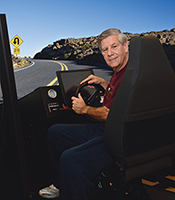 Driving Simulator: Using a high tech driving simulator, our Certified Driving Rehabilitation Specialist (CDRS) can evaluate and rehabilitate individuals who have sustained functional loss in a safe environment, targeting specific abilities like sensory-related functions, cognitive skills and motor functions that affect a person's ability to drive. Our CDRS has the specialized skill to deliver progressive training that guides drivers through basic controls, demanding roadway scenarios, and advanced driving safety skills like hazard detection and response.
Driving Simulator: Using a high tech driving simulator, our Certified Driving Rehabilitation Specialist (CDRS) can evaluate and rehabilitate individuals who have sustained functional loss in a safe environment, targeting specific abilities like sensory-related functions, cognitive skills and motor functions that affect a person's ability to drive. Our CDRS has the specialized skill to deliver progressive training that guides drivers through basic controls, demanding roadway scenarios, and advanced driving safety skills like hazard detection and response.
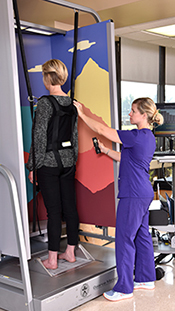 NeuroCom: The NeuroCom Smart Balance technology can be used in vestibular retraining, neurorehabilitation and fall prevention. It offers advanced computerized assessment tools to detect the underlying impairment(s) and their severity in individuals with balance deficits. This allows treatment to be specific and targeted to each individual's unique needs. The NeuroCom can also objectively track one’s progress throughout the duration of rehab.
NeuroCom: The NeuroCom Smart Balance technology can be used in vestibular retraining, neurorehabilitation and fall prevention. It offers advanced computerized assessment tools to detect the underlying impairment(s) and their severity in individuals with balance deficits. This allows treatment to be specific and targeted to each individual's unique needs. The NeuroCom can also objectively track one’s progress throughout the duration of rehab.
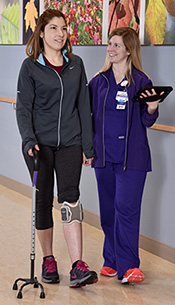 Bioness L300 Go: Bioness technology features electrical stimulation to improve foot drop (from lower leg weakness) and thigh weakness for people with many neurological diagnoses like stroke, multiple sclerosis, brain injury, or incomplete spinal cord injury. It can reduce falls and work toward individuals' independence with mobility.
Bioness L300 Go: Bioness technology features electrical stimulation to improve foot drop (from lower leg weakness) and thigh weakness for people with many neurological diagnoses like stroke, multiple sclerosis, brain injury, or incomplete spinal cord injury. It can reduce falls and work toward individuals' independence with mobility.
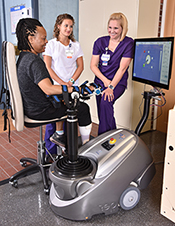 ReoGo: The ReoGo is an evidence-based robotic system used for upper extremity recovery after neurological and/or orthopedic conditions. It uses the principles of neuroplasticity to allow patients intense, repetitive practice using the affected or impaired limb. Tasks are graded to continually challenge the user. The ReoGo can be used to reduce tone and joint pain, increase range of motion, and improve coordination of movement.
ReoGo: The ReoGo is an evidence-based robotic system used for upper extremity recovery after neurological and/or orthopedic conditions. It uses the principles of neuroplasticity to allow patients intense, repetitive practice using the affected or impaired limb. Tasks are graded to continually challenge the user. The ReoGo can be used to reduce tone and joint pain, increase range of motion, and improve coordination of movement.
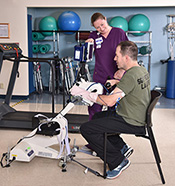 RTI Bike for the Arms: The RTI Bike for upper extremities is a machine that uses painless electrical current to stimulate nerves and generate muscle contractions. With this system, the bike creates a pattern of movement in the arms and trunk using "active therapy" where muscles are working and becoming conditioned to help reach your goals. This bike can also measure the amount of work that muscles perform during an activity.
RTI Bike for the Arms: The RTI Bike for upper extremities is a machine that uses painless electrical current to stimulate nerves and generate muscle contractions. With this system, the bike creates a pattern of movement in the arms and trunk using "active therapy" where muscles are working and becoming conditioned to help reach your goals. This bike can also measure the amount of work that muscles perform during an activity.
RTI Bike for the Legs: The RTI Bike for lower extremities is a machine that uses electrical current to stimulate nerves and generate muscle contractions. With this system, the bike creates a pattern of movement in the legs and trunk using "active therapy" where muscles are working and becoming conditioned to help reach your goals. This bike can also measure the amount of work that muscles perform during an activity.
RTI XCite: Xcite is a portable, functional electrical stimulation system that allows users to perform task-specific, strengthening and gross motor activities. This system has multiple channels, allowing therapists to facilitate muscle contraction in upper extremity, lower extremity and core muscle groups during a wide variety of actions.
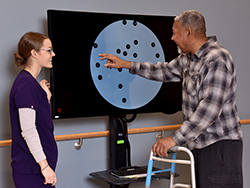 BITS: Utilizing therapeutic tools such as the BITS (Bioness Integrated Therapy System), our therapists can assess and facilitate the recovery of reaction time, memory, coordination of movement, visual fields and even cognitive and physical endurance. The BITS uses an interactive touchscreen interface, and has a diversity of programs available to meet individual patient needs. The BITS is also a fun and motivating way to do therapy!
BITS: Utilizing therapeutic tools such as the BITS (Bioness Integrated Therapy System), our therapists can assess and facilitate the recovery of reaction time, memory, coordination of movement, visual fields and even cognitive and physical endurance. The BITS uses an interactive touchscreen interface, and has a diversity of programs available to meet individual patient needs. The BITS is also a fun and motivating way to do therapy!
Bioness H200: This Bioness technology features electrical stimulation to excite weak or paralyzed muscles in the finger and thumb. It supports the wrist in a functional position allowing people to efficiently rehabilitate reaching, grasping and pinching during many daily activities.
VitalStim: is a painless non-invasive therapy approach for treating dysphagia. Electrodes are applied to the front of the neck and small electrical currents are used to stimulate the muscles responsible for swallowing. The goal is to increase muscle strength and enable brain reorganization. A certified speech therapist will use this stimulation while working on positions, maneuvers and exercises to retrain your swallow.
Guardian: is a painless, non-invasive therapy approach for treating dysphagia. Using electrodes, this device records muscle firing data and delivers fully customizable electrical stimulation to rehabilitate muscles involved in swallowing. A certified speech therapist will apply the electrodes while working on positions, maneuvers and exercises to retrain your swallow.
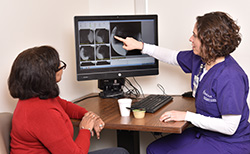 VFSS (Videofluoroscopic Swallow Study, also known as modified barium swallow): this study occurs in collaboration with a radiologist to assess swallow function. Through X-ray video imaging, it allows your speech therapist to see if food goes into your airway (aspiration) instead of your stomach. This study helps determine if your mouth and throat may not work well, what kinds of foods are safest for you to swallow, and if certain positions or strategies will improve the safety of your swallow.
VFSS (Videofluoroscopic Swallow Study, also known as modified barium swallow): this study occurs in collaboration with a radiologist to assess swallow function. Through X-ray video imaging, it allows your speech therapist to see if food goes into your airway (aspiration) instead of your stomach. This study helps determine if your mouth and throat may not work well, what kinds of foods are safest for you to swallow, and if certain positions or strategies will improve the safety of your swallow.
FEES (Fiberoptic Endoscopic Evaluation of Swallowing): this procedure uses a flexible scope with camera passed through the nose to evaluate structures, muscle movement, and coordination involved in safe swallowing.
Electrical Stimulation: this approach is painless non-invasive therapy for treating dysphagia. The goal is to increase muscle strength and enable brain reorganization.
AAC: Augmentative and Alternative Communication (AAC) can include low- or high-tech options for individuals who cannot rely on their speech. Our Speech-Language Pathologists work with those qualified to utilize high-tech AAC, usually in the form of computerized devices or communication applications on mobile devices (apps), in order to meet the person’s communication needs in all situations.
IOPI: The Iowa Oral Performance Instrument (IOPI) can be used to measure tongue and lip strength. Objective measurements can also be used to set parameters for exercise and measure individuals' improvement throughout the rehab program. The IOPI can also be used as a diagnostic tool to differentiate between muscle weakness and problems with motor control.
**Note: This material is used to provide consumers with knowledge of available technology used in treatment sessions at Inova Rehabilitation Center. It is not an endorsement of the products, companies or therapy approaches. This content is provided for informational purposes only and should not be used as a substitute for consultation with an appropriate healthcare professional. It is important that you consult with your medical professional prior to implementing any course of treatment.